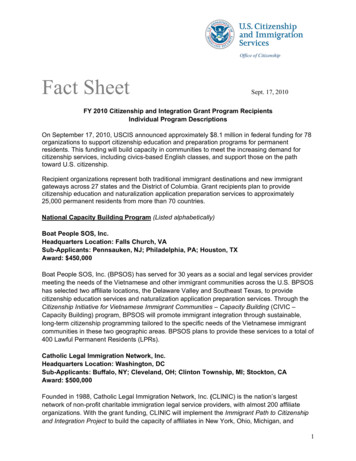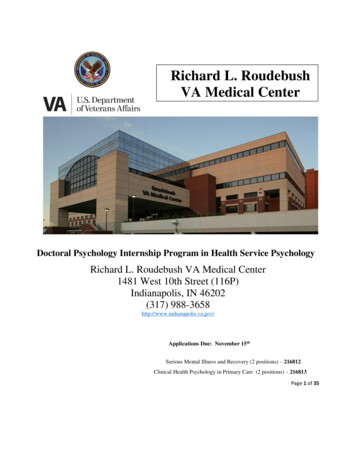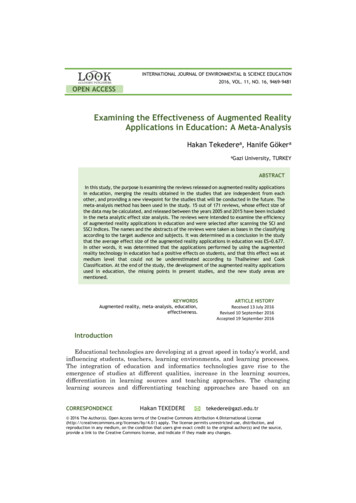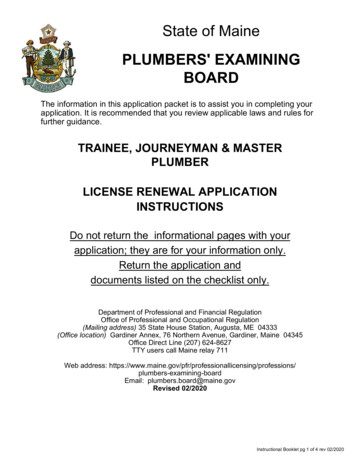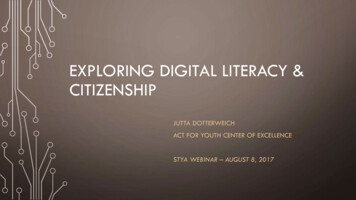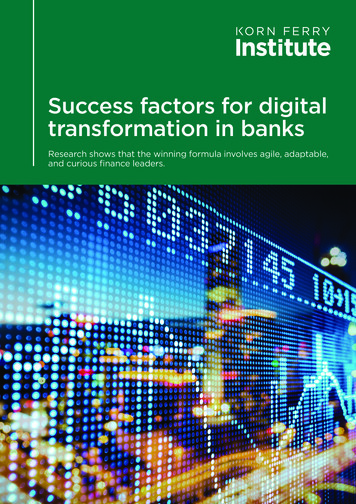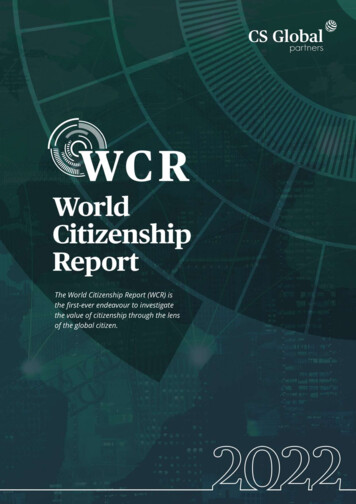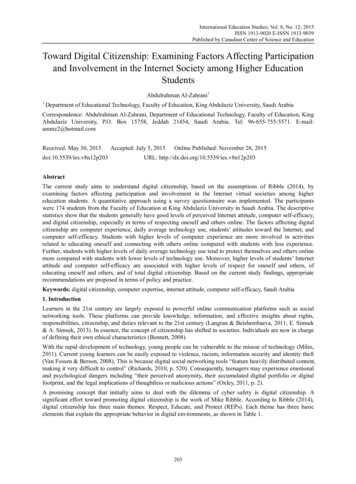
Transcription
International Education Studies; Vol. 8, No. 12; 2015ISSN 1913-9020 E-ISSN 1913-9039Published by Canadian Center of Science and EducationToward Digital Citizenship: Examining Factors Affecting Participationand Involvement in the Internet Society among Higher EducationStudentsAbdulrahman Al-Zahrani11Department of Educational Technology, Faculty of Education, King Abdulaziz University, Saudi ArabiaCorrespondence: Abdulrahman Al-Zahrani, Department of Educational Technology, Faculty of Education, KingAbdulaziz University, P.O. Box 15758, Jeddah 21454, Saudi Arabia. Tel: 96-655-755-5571. E-mail:ammz2@hotmail.comReceived: May 30, 2015doi:10.5539/ies.v8n12p203Accepted: July 5, 2015Online Published: November 26, 2015URL: http://dx.doi.org/10.5539/ies.v8n12p203AbstractThe current study aims to understand digital citizenship, based on the assumptions of Ribble (2014), byexamining factors affecting participation and involvement in the Internet virtual societies among highereducation students. A quantitative approach using a survey questionnaire was implemented. The participantswere 174 students from the Faculty of Education at King Abdulaziz University in Saudi Arabia. The descriptivestatistics show that the students generally have good levels of perceived Internet attitude, computer self-efficacy,and digital citizenship, especially in terms of respecting oneself and others online. The factors affecting digitalcitizenship are computer experience, daily average technology use, students’ attitudes toward the Internet, andcomputer self-efficacy. Students with higher levels of computer experience are more involved in activitiesrelated to educating oneself and connecting with others online compared with students with less experience.Further, students with higher levels of daily average technology use tend to protect themselves and others onlinemore compared with students with lower levels of technology use. Moreover, higher levels of students’ Internetattitude and computer self-efficacy are associated with higher levels of respect for oneself and others, ofeducating oneself and others, and of total digital citizenship. Based on the current study findings, appropriaterecommendations are proposed in terms of policy and practice.Keywords: digital citizenship, computer expertise, internet attitude, computer self-efficacy, Saudi Arabia1. IntroductionLearners in the 21st century are largely exposed to powerful online communication platforms such as socialnetworking tools. These platforms can provide knowledge, information, and effective insights about rights,responsibilities, citizenship, and duties relevant to the 21st century (Langran & Beishembaeva, 2011; E. Simsek& A. Simsek, 2013). In essence, the concept of citizenship has shifted in societies. Individuals are now in chargeof defining their own ethical characteristics (Bennett, 2008).With the rapid development of technology, young people can be vulnerable to the misuse of technology (Miles,2011). Current young learners can be easily exposed to violence, racism, information security and identity theft(Van Fossen & Berson, 2008). This is because digital social networking tools “feature heavily distributed content,making it very difficult to control” (Richards, 2010, p. 520). Consequently, teenagers may experience emotionaland psychological dangers including “their perceived anonymity, their accumulated digital portfolio or digitalfootprint, and the legal implications of thoughtless or malicious actions” (Oxley, 2011, p. 2).A promising concept that initially aims to deal with the dilemma of cyber safety is digital citizenship. Asignificant effort toward promoting digital citizenship is the work of Mike Ribble. According to Ribble (2014),digital citizenship has three main themes: Respect, Educate, and Protect (REPs). Each theme has three basicelements that explain the appropriate behavior in digital environments, as shown in Table 1.203
www.ccsenet.org/iesInternational Education StudiesVol. 8, No. 12; 2015Table 1. Main themes and elements of digital citizenship (Ribble, 2014)ThemesElements- Etiquette (electronic standards of conduct or procedure)Respect(Yourself/Respect Others)- Law (electronic responsibility for actions and deeds)- Communication (electronic exchange of information)Educate(Yourself/ConnectOthers)- Access (full electronic participation in society)withProtect(Yourself/Protect Others)- Literacy (process of teaching and learning about technology and the use oftechnology)- Commerce (electronic buying and selling of goods)- Rights and Responsibility (those freedoms extended to everyone in a digitalworld)- Safety (electronic precautions to guarantee safety)- Health and Welfare (physical and psychological well-being in a digitaltechnology world)In Saudi Arabia, it seems that the issue of digital citizenship is more problematic. Surrounded by many factorssuch as cultural-religious domination, centralization and the strong tendency toward conservatism, the case ofpreserving Saudi identity in this fast-changing digital world is challenging. However, Saudi Arabia is a rapidlydeveloping state that has willingly participated in global digital developments. This is largely linked witheconomic rapid growth that reflects the wide consumption of technology (Onsman, 2011). In this regard,Onsman (2011) argued that “ultimately, international competitiveness is likely to impact significantly andpossibly irrevocably on Saudi cultural traditions and religion norms” (p. 1). Accordingly, the current researchaims to understand students’ digital citizenship in higher education as well as to investigate factors that mayinfluence their digital behaviors in the context of Saudi Arabia, which can be sometimes problematic tounderstand and in many cases hard to predict.1.1 The Landscape of Digital CitizenshipDigital citizenship refers to “the norms of appropriate, responsible behavior with regard to technology use”(Ribble, 2014). Miles (2011, pp. 1-2) defined it as “a sensible and reasonable approach to online interaction.”Another definition was provided by Farmer (2011), who defined it as “the ability to use technology safely,responsibly, critically, productively, and civically” (p. 292). Digital citizenship advocates “the appropriate use oftechnologies in social contexts, including educational contexts” (Nosko & Wood, 2011, p. 406). This concept hasthe core objective of helping young generations to make wise and reasonable choices in various digital settingsand situations (Farmer, 2011; Hollandsworth, Dowdy, & Donovan, 2011; Kassam, 2013; Roh, 2004; Miles, 2011;Ribble, 2014). Simply put, it is the new code of civil rights for the current digital learners (B. Sutton, V. Sutton,& Plants, 2012).In view of this, it can be argued that education can be the most effective way to protect students from risksassociated with online participation (Binkley et al., 2012; Farmer, 2011; Hollandsworth et al., 2011; Ohler, 2010,2011; Oxley, 2011; Ribble, 2012; Richards, 2010; Roh, 2004; Van Fossen & Berson, 2008; Zwart, Lindsay,Henderson, & Phillips, 2011). Given the importance of digital citizenship education, Hollandsworth et al. (2011)stated, “The growing level of Internet access and student use, both in and out of school, raises the question, whowill own this challenge of guiding students toward a productive and safe technological society?” (p. 38). Apromising answer is provided by Nosko and Wood (2011), who emphasized that the development of digitalcitizenship requires effective collaboration between educators, students and the whole educational system toformulate effective codes of conduct and to facilitate culturally appropriate behaviors online.One significant duty of 21st century educators is to teach current learners about cyber safety in order to addressand prevent technology misuse (Farmer, 2011; Oxley, 2011; Van Fossen & Berson, 2008). Oxley (2011) arguedthat it is critical to educate youth about the risks related to inappropriate or unethical use of technology,especially the Internet. To do so, it is important to have specifically tailored educational activities that focus onproviding necessary skills and relevant information about risks associated with digital technologies (Van Fossen& Berson, 2008; Zwart et al., 2011). Through education, new skills that meet the demands of the 21st centuryshould substitute the basic skills and knowledge of the past (Binkley et al., 2012; Chee, Mehrotra, & Liu, 2013;204
www.ccsennet.org/iesInternationnal Education StuudiesVol. 8, No. 12; 2015Larson & Miller, 2011; Ribble, 20122). Hollandswoorth et al. (20011) concludedd that if the ccurrent educattionalparadigmss do not responnd to these issuues, “the digital culture estabablishes its ownn direction, pootentially pushing aproductivee, long-term soolution furtherr out of reach” (p. 37). Howeever, teaching digital citizennship is not an easymission. Itt can be puzzzling, considerring the prevaiiling traditionaal paradigms in education ((Chee et al., 2013;2Nosko & Wood, 2011; Ohler, 2011; Ribble, 20122; Sutton et all., 2012). Anoother associateed problem iss thateducators usually perceiive digital citizenship as a ““technology prroblem rather than a societaal issue that afffectseveryone” (Ribble, 20122, p. 149).The emergging digital cittizenship has ggained increasiing global atteention. Internaational organizations interested inpromotingg meaningful learninglthat iis more relevaant to the digittal era are in a race to encourage safer cybercparticipatioon. For instannce, the most recent technoology standardds for studentss developed byy the InternattionalSociety foor Technology in Education (ISTE) contaained a major category abouut digital citizzenship. Underr thiscategory, tthe standards are: (a) to addvocate and practice safe, llegal, and respponsible use oof informationn andtechnologyy; (b) to exhibbit a positive aattitude towardd using technoology that suppports collaboraation, learning, andproductivity; (c) to demmonstrate persoonal responsibbility for lifeloong learning; aand (d) to exhhibit leadership fordigital citizzenship (ISTEE, 2007).1.2 Factorrs Influencing DigitalDCitizennshipThe currennt study hypottheses that diggital citizenshiip, as an expecctation of everryday life digiital routine, caan beinfluencedd by the indivviduals’ attituddes toward thhe Internet, the way they trrust their techhnological abiilities(self-efficaacy) as well ass their computeer expertise. Foor more illustrration, see Figuure 1.Computer DigitalCCitizenshipFiguure 1. Factors iinfluence digitaal citizenshipmission in the ppromotion of digitalFor instancce, students’ atttitudes towardd computers annd technology play a core mcitizenshipp (ISTE, 20077). A positivee relationship between techhnology attitudes and digittal citizenship wassuggested in the work ofo Shelley et aal. (2004), whho found a dirrect linkage between technoology attitudess anddigital citiizenship that couldchelp briidge the gap iin the digital ddivide in the UUnited States. In this regarrd, E.Simsek annd A. Simsek (2013)(argued: “People becaame addicted tto informationn. Readers, as the audience, havebecome ddigital users. InformationIprrocessing has been transforrmed from beeing passive rreceivers to activeainformatioon processors, who must enngage, construct, respond, aand act with innformation” (pp. 127). Thereefore,enhancing learners’ attittudes toward ccomputers and technology shhould be a conntinuous proceess if technology isto be used in teaching annd learning appproaches (Samm, Othman, & NNordin, 2005).Another faactor that seemms to have eaarned little atteention in the eexisting literatture and may hhave an impacct ondigital citizenship is the learners’ compputer self-efficcacy. Self-efficcacy is definedd as the individdual’s judgemeent ofhis or herr ability to exxecute a certain and condittioned course of behavior/ss or to compleete specified tasks(Bandura, 1997). Differeences in self-effficacy levels occur dependiing on several key questions, including thee wayindividuals construe themmselves, the aattributes they think they posssess, the roless they presumee they are expeectedto play, thee capabilities theytbelieve thhey have acquired, the viewss they share wwith others, andd their judgmeent ofhow they aare viewed by others (Bong & Skaalvik, 20003). Wangpippatwong, Chuttimaskul, and PPapasratorn, (22008)conductedd a study to iddentify factors influencing ddigital citizens’ intention to use e-governmment websites. The205
www.ccsenet.org/iesInternational Education StudiesVol. 8, No. 12; 2015results showed that computer self-efficacy is positively correlated with the intention to use e-governmentservices and effectively participate in virtual environments.A third potential factor that the current study aims to investigate is computer expertise, in terms of computerqualifications, computer experience, and daily average computer use. The role of computer expertise inpromoting high levels of computer efficiency, especially in education, is well documented in the literature. Withthe wide expansion of technology use in today’s societies, “students need increased expertise in digitaltechnologies” (Larson & Miller, 2011, p. 122). In this regard, Vannatta (2007) argued that “technology skills andfluency are essential to using technology” (p. 136). Bahr, Shaha, Farnsworth, Lewis, and Benson (2004) statedthat it is widely acknowledged that increased skills and knowledge about technology through practice areinterrelated with increased motivation and willingness to use technology. As Georgina and Hosford (2009) found,the relationship between technology literacy and practice is significantly mutual. However, there is lesserevidence with regard to the impact of computer expertise on digital citizenship. This impact is what the currentstudy intends to explore.2. Research ProblemAlthough digital citizenship may be part of the equation toward achieving effective use of technology andlessening its negative effects, efforts to control the risks associated with digital technologies are “fraught withdifficulties” and still long overdue (Van Fossen & Berson, 2008, p. 122). Besides, the existing literature giveslittle focus to factors that may affect digital citizenship. In the context of Saudi Arabia, there is a clear absent ofauthentic research devoted for understanding digital citizenship, especially among higher education students.3. Research Aim and Key QuestionsThe current study, therefore, aims to understand digital citizenship, as well as identify factors that may lead tothe development of higher education students’ digital characteristics. The current study adopts the theoreticalframework of Ribble (2014). The following research questions guide the study: What is the level of students’ digital citizenship in terms of REPs? Does computer expertise (experience, daily average use, and qualifications) impact students’ digitalcitizenship in terms of REPs? Does students’ Internet attitude impact their digital citizenship in terms of REPs? Does students’ perceived computer self-efficacy impact their digital citizenship in terms of REPs?4. MethodologyTo answer the research questions, a quantitative approach was implemented using survey questionnaire to collectthe data.4.1 SamplingThe strategy used in the current study is probability sampling, in which there is a possibility for every member ofthe population to participate (Mertens, 2005). Thus, probability sampling allows a random convenience sampleto take part in the study (Mertens, 2005).The context was the Faculty of Education at King Abdulaziz University. More than 250 students showedwillingness to participate in the current study, which used the snowball technique to recruit respondents (Mertens,2005). A total of 213 completed questionnaires were collected and checked after the deadline for submission.After excluding those with more than 85 percent incomplete data, the final number of useable questionnaires was174, yielding a return rate of about 82 percent.4.2 Questionnaire DesignThe questionnaire included two major sections: (a) general information and (b) digital citizenship. A five-pointLikert scale (5 strongly agree, 1 strongly disagree) was used to classify the students’ responses. The firstsection aimed to collect general information and respondents’ perception on the possible factors that may impactstudents’ digital citizenship. It gathered information on students’ computer experience, daily average computeruse, and computer qualifications (computer expertise). It also investigated two technology-related perceptions:Internet attitude and computer self-efficacy.The scale used for Internet attitude was a modified version of Sam et al. (2005) who originally adapted theComputer Attitude Scale that has 20-item, developed and validated by Nickell and Pinto (1986). The internetattitude scale in the current study has only 10 items (see Appendix 1). For computer self-efficacy, the scale wasoriginally designed for the current study; this scale consists of 18 items (see Appendix 2).206
www.ccsenet.org/iesInternational Education StudiesVol. 8, No. 12; 2015The digital citizenship scale in the second section was specifically designed for the current study based on theassumptions of Ribble (2014). It includes 46 items categorized in three main sections (Subscales), whichintended to meet the three main themes of REPs (see Appendix 3). The number of items included in eachsubscale is presented in Table 2.Table 2. Digital citizenship scale (REPs)SubscaleNRespect Yourself/Respect Others24Educate Yourself/Connect with Others11Protect Yourself/Protect Others11Total464.3 Validity and ReliabilityThe vast majority of the participants spoke the Arabic language. Therefore, the questionnaires were firstdeveloped in English and subsequently translated into Arabic before distribution. Because the Arabic language isthe researcher’s mother tongue, the researcher himself translated the questionnaire to ensure its accuracy.According to Mertens (2005), “because survey research uses decontextualized words through its very nature, theresearcher must be careful to interpret the words in light of the particular cultural circumstances” (p. 185). Hence,three specialists and Arabic native speakers reviewed the translation to ensure its accuracy and clarity.The questionnaire validity was tested by having a panel of experts check its relevance, content, and construction(Mertens, 2005). Based on these experts’ opinions, necessary and appropriate changes were made. Reliabilitystatistics obtained using Cronbach’s alpha coefficient indicated acceptable internal consistency levelsexceeding .7 (Pallant, 2007). See Table 3.Table 3. Reliability statisticsAttitude and Self-efficacyDigital 318Respect Yourself/Respect Others9024Educate Yourself/Connect with Others.8811Protect Yourself/Protect Others.8311Total Digital Citizenship.89469274Total Questionnaire5. Results5.1 Students’ Computer ExpertiseInvestigating the students’ technological expertise included determining their computer experience, daily averagecomputer use, and computer qualifications (see Table 4).207
www.ccsenet.org/iesInternational Education StudiesVol. 8, No. 12; 2015Table 4. Students’ computer expertise (n 174)Computer ExpertiseComputer ExperienceDaily Average Computer UseComputer QualificationsGroupN%Less than 5 Years7040.2From 5 to 10 Years9554.6More than 10 Years95.2Less than 1 Hour3620.7From 1 to 5 Hours11867.8More than 5 Hours2011.5No Qualifications12169.5Short Courses5330.5MSD1.650.581.910.561.300.46The data in Table 4 show that most of the students have an average computer experience of between 5 to 10years. Although most of the students have no computer qualifications, they reported a high daily average use of 5hours or more.5.2 Students’ Internet Attitude and Computer Self-EfficacyTo gain a general picture of the students’ Internet attitude, the total mean of their responses was calculated (seeTable 5).Table 5. Attitude and computer self-efficacy (n 174)ScaleMSDTotal Attitude4.520.36Total Computer Self-efficacy4.100.66As shown in Table 5, the total mean indicates that the students have very good levels of perceived Internetattitude (M 4.52). The data also show that the students tend to have a good level of computer self-efficacy (M 4.10) and that they trust their abilities to deal with computer technology and implement it to satisfy their needs.5.3 Students’ Digital CitizenshipOne of the main purposes of the current study is to understand students’ digital citizenship. As previouslydiscussed, the digital citizenship scale was divided into three subscales. The total mean score for each subscale,as well as the total mean for the scale, are shown in Table 6.Table 6. Digital citizenship (n 174)SubscaleMSDTotal Educate Yourself /Connect with Others3.610.78Total Protect Yourself/Protect Others3.630.78Total Respect Yourself/Respect Others4.370.51Total Digital Citizenship4.010.43Based on the data in Table 6, the total mean for students’ digital citizenship is 4.01, which indicates good levels.However, the digital citizenship practices with the highest mean are those concerning respect for oneself andothers (M 4.37). This is followed by practices with regard to protecting oneself and others (M 3.63) andeducating oneself/connecting with others (M 3.61), which showed similar results.5.4 Students’ Computer Expertise Influences Digital CitizenshipA one-way between-groups multivariate analysis of variance (MANOVA) was performed to investigate theimpact of the students’ computer expertise, which includes their computer experience, daily average computer208
www.ccsenet.org/iesInternational Education StudiesVol. 8, No. 12; 2015use, and computer qualifications as dependent variables, on their digital citizenship (independent variable).Preliminary assumption testing was conducted to check the sample distribution, linearity, normality,multicolinearity, univariate and multivariate outliers, and homogeneity of variance-covariance with no seriousviolations noted. Accordingly, Wilks’ lambda values (λ) are shown in Table 7.Table 7. Impact of computer expertise on students’ digital citizenship (MANOVA)EffectWilks' λFHypothesis dfError dfSig.partial η2Computer Experience.883.386314.003.088Daily Average Computer Use.883.396314.003.083Computer Qualifications.971.613157.190.056The MANOVA results indicate a statistically significant impact of the students’ computer expertise on theirdigital citizenship, as follows: Computer experience [F (6, 314) 3.38, p .003; Wilks’ λ .88; partial eta squared .088]. Computer daily average use [F (6, 382) 3.39, p .003; Wilks’ λ .88; partial η2 .083].Table 8 shows the impacts that reached statistical significance when the results for the dependent variables wereconsidered separately.Table 8. Test results for between-subjects effectsSourceDependent l η2ComputerExperienceEducateYourself/Connect with Others6.9723.487.85.001.090DailyAverageComputer UseProtect Yourself/6.1723.096.27.002.073Protect OthersComputer experience showed a statistically significant impact on students’ digital participation in terms ofeducating oneself and connecting with others [F (1, 174) 7.85, p .001, partial η2 .090]. An examination ofthe mean scores indicated that students with computer experience ranging from 5 to 10 years (the majority) weremore involved in activities related to educating oneself and connecting with others (M 4.04) compared withstudents with less than 5 years of computer experience (M 3.65).The students’ daily average computer use was found to significantly impact practices with regard to protectingoneself and others [F (1, 174) 6.27, p .002, partial η2 .073]. The mean differences show that students withthe highest daily average computer use (more than 5 hours a day) tend to protect themselves and others in digitalactivities (M 3.80) more compared with those with a daily average computer use of less than 1 hour (M 3.18)or 1 to 5 hours (M 3.73).5.5 Students’ Attitudes and Self-Efficacy Impact Digital CitizenshipBy using Pearson’s product-moment correlation coefficients, the relationships between the students’ Internetattitude, computer self-efficacy, and digital citizenship were investigated, revealing six positive correlations (seeTable 9).209
www.ccsenet.org/iesInternational Education StudiesVol. 8, No. 12; 2015Table 9. Pearson’s correlations for students’ attitudes, self-efficacy, and digital rself/Connectwith OthersProtectYourself/ProtectOthersTotal (n cacyPC.297(n 174)Sig.000**.367.000****: The correlation is significant at the 0.01 level (2-tailed); PC, Pearson correlation.As the data in Table 9 suggest, higher levels of students’ Internet attitude are associated with higher levels ofrespect for oneself and others online [r .354, n 174, p .000]. Also, higher levels of students’ Internetattitude are strongly correlated with practices of educating oneself and others online [r .247, n 174, p .001].The total digital citizenship is positively correlated with students’ Internet attitude [r .363, n 174, p .000].However, no correlation was found between students’ Internet attitudes and practices toward protecting oneselfand others online.Similarly, higher levels of students’ computer self-efficacy are associated with higher levels of respect foroneself and others online [r .297, n 174, p .000]. Further, higher levels of students’ computer self-efficacyare positively correlated with the stance of educating oneself and others online [r .367, n 174, p .000].Higher levels of students’ computer self-efficacy are also strongly linked to higher levels of total digitalcitizenship [r .408, n 174, p .000]. Pearson’s correlation coefficients suggest no relationship betweenstudents’ computer self-efficacy and their practices of protecting oneself and others online.6. DiscussionThe background information revealed that most of the students have an average computer experience of between5 to 10 years. Although most of the students have no computer qualification, they reported a high daily averageuse of five hours or more. This pattern mirrors the rapid increase in the use of technology as a global power.The results also indicate that the students have good levels of perceived Internet attitude and computerself-efficacy. The students perceive the Internet as a useful tool for effective participation in the 21st century.They themselves can be seen as motivated learners who generally trust their abilities to integrate technology intotheir daily lifestyles, including learning activities. This result also can be supported by the assumption found inthe current study in which no connection was found between technology computer qualification and digitalcitizenship.The students correspondingly showed good levels of digital citizenship, especially in terms of respecting oneselfand others online. This, in particular, indicates that respect is a main issue for students engaged in virtualcommunities. Clearly, students prefer to participate in respectable, proper, and suitable online communities inwhich they feel respected and can show respect to others. It appears that students reject the notion ofcyberbullying and believe in the importance of respecting others’ identities, cultures, and human rights. Theliterature suggests that respect, especially for others, is vital in digital societies, “since it is becoming mucheasier to infringe others’ rights due to the advances of ICTs” (Roh, 2004, p. 168). Respect has become anecessity for global learners in the 21st century, both in and out of the digital environment. Kassam (2013)argued that:Much preparation for the social aspects of discussion, which include respect and responsibilityfor the welfare of all, the critical literacy required for the fast paced transparent and interactiveworld of the digital media, good responsible citizenship and the ability to discuss and arguewith respect for everyone, are skills that can be taught in the classroom without the latestaccess to social networks in the Web 2.0 world. (p. 261).Another interesting result is that students with higher levels of computer experience were found to be moreinvolved in activities related to educating oneself and connecting with others online compared with students withless computer experience. Apparently, students with higher levels of computer experience tend to share theirknowledge with others online and create more effective ways of communication. Computer experience seems toplay a catalyst role in seeking and exchanging information with others online.210
www.ccsenet.org/iesInternational Education StudiesVol. 8, No. 12; 2015Further, students with higher levels of daily average technology use tend to protect themselves and others in thedigital environment more compared with students with lower daily average technology use. Security issues seemvery important to students who use technology extensively on a daily basis. Therefore, it is important for them toprotect themselves and share relevant information with others online.The current study also found that higher levels of students’ attitudes toward the Internet are associated withhigher levels of respect for oneself and others, of educating oneself and others, and of total digital citizenship.The way students feel about the Internet and its implications appear to impact the way they perceive their digitalidentities. Students with good levels of attitudes toward the Internet can be better digital citizens who respectthemselves and others and may ef
A promising concept that initially aims to deal with the dilemma of cyber safety is digital citizenship. A significant effort toward promoting digital citizenship is the work of Mike Ribble. According to Ribble (2014), digital citizenship has three main themes: Respect, Educate, and Protect (REPs). Each theme has three basic

